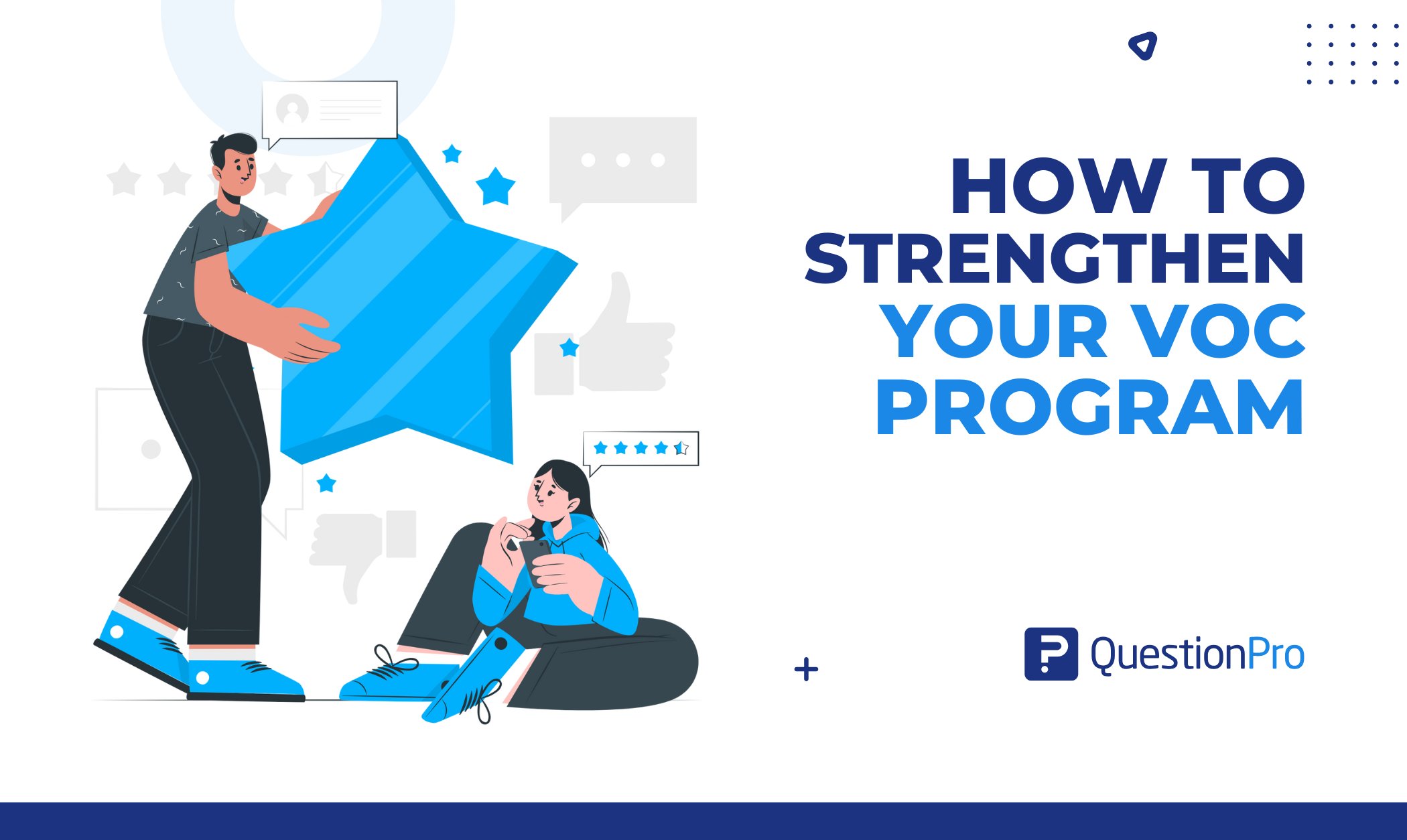
Voice of Customer (VoC) is extremely important in creating the best products and offering the best services in any industry. However, implementing the best practices in Voice of Customer surveys is one of the most common challenges organizations face. If you’re wondering how to strengthen your VoC program, follow these best practices using effective Voice of Customer tools.
What is the Voice of Customer Program?
In market research, Voice of Customer (VoC) refers to customer feedback about their experiences with your products and services. A well-designed VoC program helps you better understand customer choices, concerns, and preferences.
But collecting feedback isn’t enough. What truly sets a VoC program apart is how the data is analyzed, and more importantly, how businesses use the insights generated by a Voice of Customer program.
With 90% of companies competing primarily on customer experience, falling behind could mean losing relevance. Today’s high-growth companies are built on a customer-focused mindset. So, the question is:
Does your brand have what it takes to compete in this landscape?
An effective Voice of Customer survey program should surface customer experiences, expectations, and hidden insights from feedback data. By truly listening to the voice of the customer, organizations gain valuable insights into customer concerns, brand perception, and purchase motivations. Throughout the direct feedback collection process, the ultimate goal is to deliver the best possible customer experience.
Continue Reading: Voice of the Customer Programs: What It Is, Implementations
How to Strengthen Your VoC Program with Customer-Centric Best Practices?
To get a competitive advantage, it is necessary to reach out to the customers wherever they are and listen to what they have to say about you. Having listened to customer expectations, it is time for you to act fast, to show your customers how much you value their opinions and suggestions.
When you have a well-designed VoC program, gathering good-quality data becomes easier. Regardless of the method you chose to collect the data, ensuring you are giving enough liberty to the customers to share their views and perspectives matters a lot in the VoC program. Customer views and their perception bring the ultimate value to your voice of the customer surveys.
Organizations use the Voice of the Customer program not only to get actionable insights but also to receive early alerts, warnings, and direction from the people who matter. Try these five best practices for strengthening your VoC program.
Connect the Insights Across All Data Channels
In a world where everything is online, many organizations still rely on a single channel to measure and optimize their customer interactions. Not only it creates barriers but it also limits the precision and depth of the customer insights.
When organizations don’t use effective Voice of Customer tools, they risk:
- Incomplete or fragmented survey feedback
- Bad quality data on customer behavior and satisfaction
- Missed opportunities to understand customer needs in real time
To strengthen your VoC program, you need to gather customers’ feedback at every touchpoint or every stage of the customer journey.
Here’s how to do it:
- Connect survey responses across all data channels
- Choose a VoC software that integrates with your existing CRM, marketing automation, and analytics platforms.
- Break down data silos to create a unified view of the customer experience.
Collaborate on Survey Data Across All Departments with a Go-To Action Plan
A strong Voice of Customer program isn’t effective unless all internal departments are actively involved in the program. Ensure all the teams are included in the voice of the customer program so that they can be of assistance in collecting, analyzing, and acting on the insights.
It is recommended to strengthen their involvement using action planning tools that can help with:
- Assign clear ownership
- Define start and end dates
- Share responsibilities
- Provide visibility into the action plan
One of the best VoC practices is to align teams around a shared roadmap. With a well-structured go-to action plan, your organization is better equipped to turn insights into actions and actions into an improved customer experience.
Include the Voice of the Employee for Better Output
A customer feedback program that ignores the connection between employees and customers can weaken your overall impact. By considering the voice of the employee, you can get insight into the challenges your team faces and challenges that may create bottlenecks in delivering excellent customer experiences.
Addressing employee concerns empowers your team to perform at their best, which directly translates into providing outstanding experiences for your customers.
An efficient tool to gauge the voice of the customers provides the flexibility to configure and customize the dashboard for each department and provide them with relevant insights related to their role in providing customer satisfaction.
Sharing VoC data across teams helps to:
- Keep everyone aligned and informed
- Show how customers perceive the brand
- Bridge gaps for teams that don’t interact directly with customers
It is good practice to share the VoC survey results so that they can learn more about the end-user experience. This can also help strengthen your VoC program.
Measure ROI
Investing enough in the voice of customer surveys will ensure customer satisfaction and hence, loyalty. It boosts sales and strengthens your brand.
Another metric for measuring the ROI is an improvement in the NPS. If customers start developing a better impression of you, they are more likely to refer your business to their friends and family. So, if detractors and passives convert into promoters, it can be considered a huge success.
You can also track other key metrics like Customer Satisfaction Score (CSAT) and Customer Effort Score (CES) to get a fuller picture of your program’s impact.
In Case You Missed It: Voice of the Customer Strategy
Conclusion
If customers feel you are listening to their voices and taking action, they will feel more connected with your brand. It is always advisable to be in constant touch with the customers to understand their pulse before it’s too late. Not listening to the voice of your customers is a bad practice. This can lead to them being lost to your competitors.
Last but not least, encourage your customers to share more feedback and more often, so that you always have a clear picture of how it’s going.
At QuestionPro, we work on what we believe in. Schedule a demo with Ken and discover how to boost customer loyalty and collect valuable consumer insights through our CX survey and analytics management platform.







